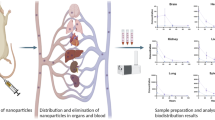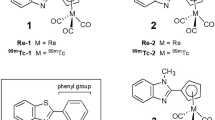Abstract
Bioquin-HMPAO (BH) was previously investigated as a novel brain imaging agent by in vivo biodistribution studies. Present studies are carried out to explore radiolabeling and in vitro behaviour evaluation of poly (lactic-co-glycolic acid) (PLGA) encapsulated BH nanocapsules (BH-PLGA NCs). BH-PLGA NCs were characterized utilizing dynamic light scattering and scanning electron microscope. Encapsulation effect on radiolabeling with 99mTc was examined by stability and lipophilicity studies and effect on in vitro behaviour of 99mTc-BH was evaluated by incorporation studies on DAOY, U87-MG and A549 cells. It is observed that PLGA encapsulation has a positive and reinforcement effect.






Similar content being viewed by others
References
Yurt Kilcar A, Biber Muftuler FZ, Enginar H, Tekin V, Medine EI, Unak P (2014) Synthesis, characterization and biodistribution of 99mTc-Bioquin-HMPAO (99mTc-BH) as a novel brain imaging agent. J Radioanal Nucl Chem 302:563–573
Kulkarni PV, Roney CA, Antich PP, Bonte FJ, Raghu AV (2010) Quinoline-n-butylcyanoacrylate-based nanoparticles for brain targeting for the diagnosis of Alzheimer’ s disease. WIREs Nanomed Nanobiotechnol 2:35–47
Duncan R (2003) The dawning era of polymer therapeutics. Nat Rev Drug Discov 2:347–360
Roney C, Kulkarni P, Arora V, Antich P, Bonte F, Wu A (2005) Targeted nanoparticles for drug delivery through the blood-brain barrier for Alzheimer’s disease. J Control Release 108:193–214
Gutman RL, Peacock G, Lu DR (2000) Targeted drug delivery for brain cancer treatment. J Control Release 65:31–41
Roney CA, Arora V, Kulkarni PV, Antich PP, Bonte FJ (2009) Nanoparticulate radiolabelled quinolines detect amyloid plaques in mouse models of Alzheimer’s disease. Int J Alzheimers Dis 2009:1–8
Alexis F, Pridgen E, Molnar LK, Farokhzad OC (2008) Factors affecting the clearance and biodistribution of polymeric nanoparticles. Mol Pharm 5:505–515
Locatelli E, Comes Franchini M (2012) Biodegradable PLGA-b-PEG polymeric nanoparticles: synthesis, properties, and nanomedical applications as drug delivery system. J Nanoparticle Res 14(1316):1–17
Kreuter J (1996) Nanoparticles and microparticles for drug and vaccine delivery. J Anat 189:503–505
Acharya S, Sahoo SK (2011) PLGA nanoparticles containing various anticancer agents and tumour delivery by EPR effect. Adv Drug Deliv Rev 63:170–183
Pereira MA, Mosqueira VCF, Vilela JMC, Andrade MS, Ramaldes GA, Cardoso VN (2008) PLA–PEG nanocapsules radiolabeled with 99mTc-HMPAO: release properties and physicochemical characterization by atomic force microscopy and photon correlation spectroscopy. Eur J Pharm Sci 33:42–51
Mosqueira VC, Legrand P, Gulik A, Bourdon O, Gref R, Labarre D, Barratt G (2001) Relationship between complement activation, cellular uptake and surface physicochemical aspects of novel PEG-modified nanocapsules. Biomaterials 22:2967–2979
Singh UV, Bisht KS, Rao S, Devi PU, Udupa N (1996) Plumbagin-loaded PLGA Microspheres with Reduced Toxicity and Enhanced Antitumour Efficacy in Mice. Pharm Pharmacol Commun 2:407–440
Brannon-Peppas L (1995) Recent advances on the use of biodegradable microparticles and nanoparticles in controlled drug delivery. Int J Pharm 116:1–9
Peltonen L, Koistinen P, Karjalainen M, Häkkinen A, Hirvonen J (2002) The effect of cosolvents on the formulation of nanoparticles from low-molecular-weight poly(l)lactide. AAPS PharmSciTech 3:52–58
Cu Y, Saltzman WM (2009) Controlled surface modification with poly(ethylene)glycol enhances diffusion of PLGA nanoparticles in human cervical mucus. Mol Pharm 6:173–181
Yurt Kilcar A, Tekin V, Biber Muftuler FZ, Medine EI (2015) 99mTc labeled plumbagin: estrogen receptor dependent examination against breast cancer cells and comparison with PLGA encapsulated form. J Radioanal Nucl Chem. doi:10.1007/s10967-015-4284-1
Musumeci T, Ventura CA, Giannone I, Ruozi B, Montenegro L, Pignatello R, Puglisi G (2006) PLA/PLGA nanoparticles for sustained release of docetaxel. Int J Pharm 325:172–179
Zhen W, Han H, Anguiano M, Lemere CA, Cho CG, Lansbury PT (1999) Synthesis and amyloid binding properties of rhenium complexes: preliminary progress toward a reagent for SPECT imaging of Alzheimer’s disease brain. J Med Chem 42:2805–2815
Mele’ndez-Alafort LM, Riondato M, Nadali A, Mele L, Banzato A, Camporese D, Boccaccio P, Uzunov N, Rosato A, Mazzi U (2006) Bioavailability of 99mTc-Ha-paclitaxel complex [99mTc-ONCOFID-P] in mice using four different administration routes. Nucl Med Biol 49:939–950
Mirahmadi N, Babaei MH, Vali AM, Daha FJ, Kobarfard F, Dadashzadeh S (2008) 99mTc-HMPAO-labeled liposomes: an investigation into the effects of some formulation factors on labeling efficiency and in vitro stability. Nucl Med Biol 35:387–392
Mora-Huertas CE, Fessi H, Elaissari A (2010) Polymer-based nanocapsules for drug delivery. Int J Pharm 385:113–142
Ballinger JR, Duncan J, Hua AH, Ichise M (1997) Accumulation of 99mTc-HMPAO and 99mTc-ECD in rodent and human breast tumor cell lines in vitro. Ann Nucl Med 11:95–99
Chattopadhyay S, Das MK, Vanaja R, Ramamoorthy N (2001) Purification and stabilization of 99mTc-d, l-HMPAO: role of organic extractants. Nucl Med Biol 28:741–744
Schwochau K (2000) Technetium chemistry and radiopharmaceutical applications. Wiley-VCH, Winheim
Dischino DD, Welch JM, Kilbourn RM, Raichle EM (1983) Relationship Between Lipophilicity and Brain Extraction of C-11-Radiopharmaceuticals. J Nucl Med 24:1030–1038
Zolle I (2007) 99mTc pharmaceuticals preparation and quality control in nuclear medicine. Springer, New York
Acknowledgments
Current work is supported by Ege University Research Fund (contract no 2011 NBE 003). The authors thank to Cansu Uzaras and Çiğdem İçhedef for the technical assistance during the assays.
Author information
Authors and Affiliations
Corresponding author
Rights and permissions
About this article
Cite this article
Yurt Kilcar, A., Biber Muftuler, F.Z., Medine, E.I. et al. PLGA encapsulation effect on Bioquin-HMPAO: radiolabeling and in vitro behaviour on brain and lung cancer cells. J Radioanal Nucl Chem 310, 155–164 (2016). https://doi.org/10.1007/s10967-016-4746-0
Received:
Published:
Issue Date:
DOI: https://doi.org/10.1007/s10967-016-4746-0




